In the vast cosmic theater, there exists an event that stirs the imagination and invokes a sense of wonder like no other—a solar eclipse. As the heavens choreograph this grand spectacle, you might wonder, how often is a solar eclipse in the US?
A solar eclipse graces the skies of the United States approximately every 18 months. These celestial events offer rare opportunities to witness the universe’s grand performance on our home soil.
In this article, you get to
Explore Solar Eclipse Frequency: Learn the frequency of solar eclipses, focusing on those occurring in the United States.
Decipher Solar Eclipse Mysteries: Understand what a solar eclipse is, the different types (total, partial, and annular), and the mechanics behind them.
Types of Solar Eclipses: Learn about the three main types of solar eclipses and the factors determining which type occurs.
Frequency of Total Solar Eclipses: Discover how total solar eclipses follow predictable patterns, influenced by the Saros cycle and the average number of solar eclipses per century.
Frequency of Solar Eclipses in the US: Understand how often solar eclipses occur in the United States and when to expect the next total eclipse.
Historical Perspective: Explore notable solar eclipses in US history and how different cultures perceived these celestial events.
Upcoming Solar Eclipses: Get a glimpse of upcoming solar eclipses visible from the United States and where to witness them.
Planning for Eclipses: Learn essential planning tips and safely observe solar eclipses, including choosing the right location and protecting your eyes.
Scientific Insights: Understand the science behind solar eclipses, including the alignment of the Sun, Moon, and Earth and the role of lunar nodes.
Final Thoughts: Reflect on the significance and beauty of solar eclipses and how they offer unique opportunities for scientific discovery and personal wonder.
By the end of this article, you’ll have a deep understanding of solar eclipses, their frequency, types, historical significance, upcoming opportunities for observation, and the science that underlies these captivating celestial events.
Let’s dive right in.
Understanding Solar Eclipses
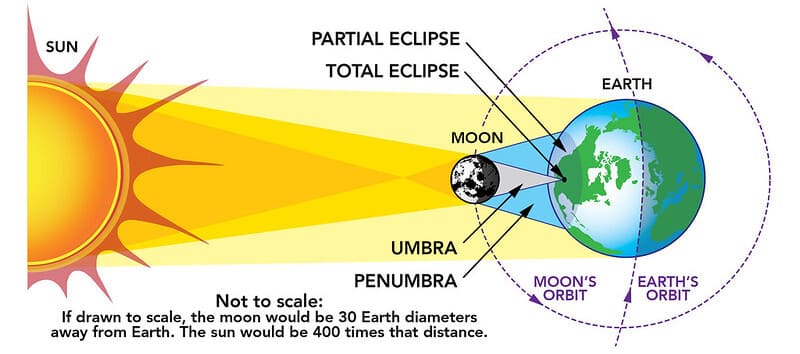
What is a Solar Eclipse?
A solar eclipse is when the Moon’s shadow falls onto the Earth’s surface, creating a dark area ranging from a few kilometers to thousands.
This shadow has two parts: the umbra, the inner and darker section where the Moon completely blocks the Sun, and the penumbra, the outer and lighter part where the Moon partially covers the Sun.
When you are within the umbra on Earth, you experience a total solar eclipse, where the Moon completely covers the Sun’s disk.
When you find yourself in the penumbra, you witness a partial solar eclipse, with only a part of the Sun’s disk obscured by the Moon.
If you are at the edge of the penumbra, you’ll see a tiny partial eclipse, where only a small sliver of the Sun’s disk is covered by the Moon.
Types of Solar Eclipses
Solar eclipses come in three main types: total, partial, and annular, and they depend on the relative distances and sizes of the Sun, Moon, and Earth.
Total Solar Eclipse
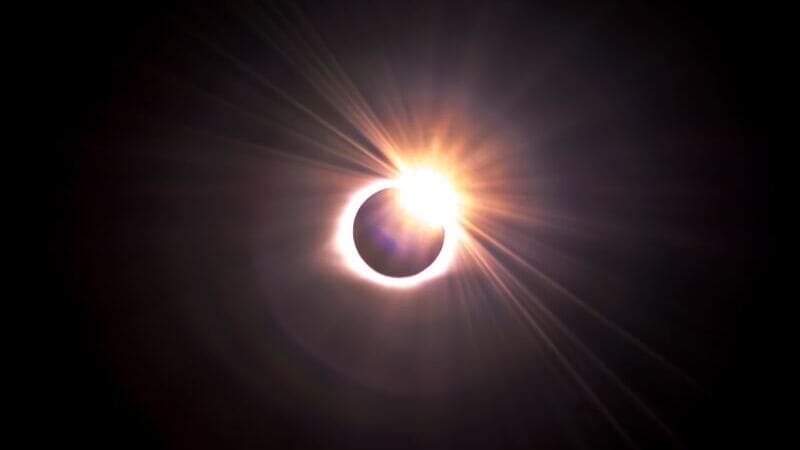
A total solar eclipse happens when the Moon gets close enough to Earth, appearing as large as or larger than the Sun. This allows the Moon to cover the Sun’s disk completely, creating a dark region on Earth known as the path of totality.
The width of the totality path can range from 50 km to 300 km.
During a total solar eclipse, the duration of totality can last up to 7.5 minutes at your location within the path.
Partial Solar Eclipse

A partial solar eclipse occurs when the Moon is farther from Earth or when the alignment of the Sun, Moon, and Earth isn’t perfect.
In this case, the Moon covers only a portion of the Sun’s disk, resulting in a partially darkened area on Earth.
You can witness a partial solar eclipse if you’re within or near the Moon’s penumbra. These partial eclipses can last several hours at your location.
annular solar eclipse
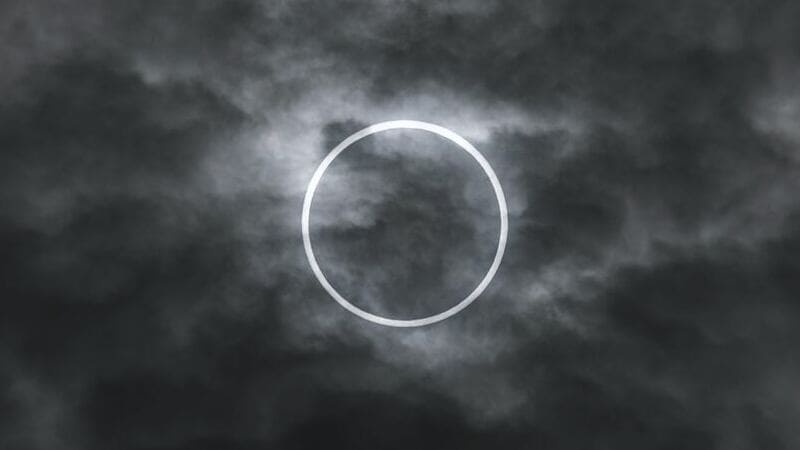
An annular solar eclipse takes place when the Moon is at its farthest point from Earth, and its apparent size is smaller than the Sun’s. Even when the Moon is directly in front of the Sun, it can’t completely cover it, creating a ring of sunlight known as an annulus or a “ring of fire.”
You can only see an annular solar eclipse if you’re within or near a narrow path called the path of annularity. The width of the path of annularity can range from about 10 km to 300 km.
During an annular solar eclipse, the duration can last up to about 12 minutes at your location within the path.
Frequency of Solar Eclipses
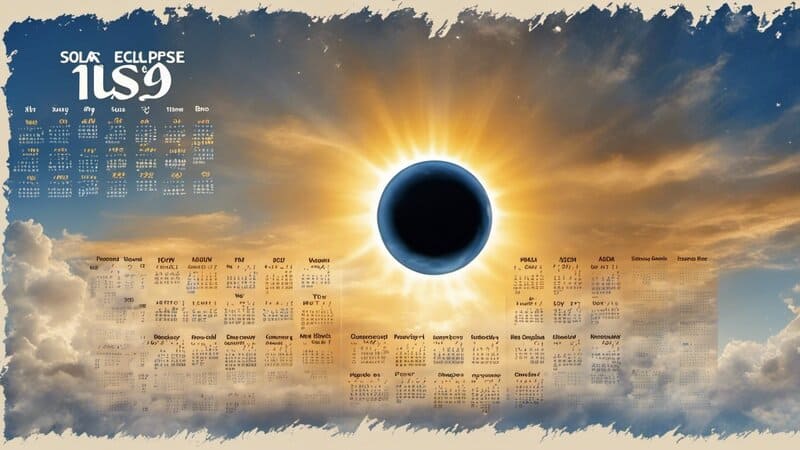
Frequency of Total Solar Eclipses on Earth
Solar eclipses aren’t random events; they follow predictable patterns that depend on the orbital motions of the Sun, Moon, and Earth. These patterns are governed by the Saros cycle, an 18-year and 11-day period (or 223 synodic months) that repeats the same sequence of eclipses. However, not every Saros cycle produces the same number of eclipses; some cycles have more than others.
On average, there are about 240 solar eclipses each century, but how often do solar eclipses occur in the US?
Most years have four eclipses, which is the minimum number; of these four eclipses, two are always solar eclipses.
The maximum number of eclipses in a calendar year is seven; of these seven eclipses, five can be solar eclipses.
The last time this happened was in 1982, and the next time will be in 2038.
how often is a solar eclipse in the US
What’s the frequency of solar eclipse in the US?
A total solar eclipse becomes visible from somewhere on Earth approximately every 18 months. However, many of these events can only be observed from remote locales, making travel difficult.
Concerning the United States, the August 21, 2017, total solar eclipse marked the first traversal of the country in nearly a century. The next total eclipse in the US will occur in April 2024.
On average, a total solar eclipse takes about 375 years to recur at the same location. In contrast, a total lunar eclipse, a Blood Moon, can be seen about every 2.5 years.
Partial and annular solar eclipses occur more frequently than total ones. Still, they are less spectacular and require special equipment and precautions to protect your eyes from the Sun’s harmful rays.
You can expect to see partial and annular solar eclipses in the US about once every year or two.
Total Solar Eclipses in the US: A Historical Perspective

Notable Solar Eclipses of the Past
Some of the most memorable and significant solar eclipses in the US history are:
- The “Great American Eclipse” on August 21, 2017, was a historic coast-to-coast total solar eclipse, spanning 14 states from Oregon to South Carolina. Hopefully, you were among the millions of others who marveled at its celestial spectacle.
- The “Einstein Eclipse” of May 29, 1919, was a pivotal moment in the world of Solar Observations. During this eclipse, American astronomers in Brazil and Principe Island tested Albert Einstein’s groundbreaking Theory of General Relativity by measuring the positions of stars near the Sun. Their findings confirmed Einstein’s prediction that gravity bends light.
- The “Transcontinental Eclipse” on June 8, 1918, was etched in the United States’ eclipse history. It was the last total solar eclipse to traverse the nation from coast to coast until 2017, gracing 15 states from Washington to Florida. Even President Woodrow Wilson witnessed this astronomical wonder from the White House lawn.
- The “King of Siam’s Eclipse” on August 7, 1869, marked a turning point for scientists. In this event, scientists used Photography and Spectroscopy for the first time to observe a total solar eclipse. This cosmic spectacle crossed nine states, from Montana to North Carolina, and drew the attention of King Chulalongkorn of Siam (now Thailand), who happened to be visiting New York City then.
- The “Independence Day Eclipse” on July 4, 1776, holds a unique place in history. This partial solar eclipse coincided with the Revolutionaries’ signing of the Declaration of Independence in most of the Original 13 Colonies. While not widely noticed or recorded, it adds an intriguing celestial note to this pivotal moment in American history.
Historical View of Solar Eclipses in the US
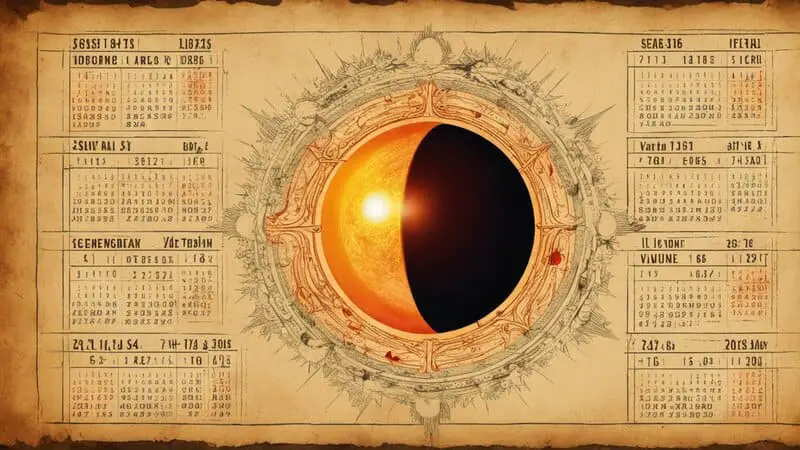
Explore the Historical View of Solar Eclipses in the US through the lens of Historical Records. These celestial events have left their mark on diverse cultures and civilizations, shaping their beliefs and traditions.
In ancient times, solar eclipses were often interpreted as Omens or messages from Gods or Spirits. While some cultures feared them as Portents of Doom or Disaster, others cherished them as Auspicious or Sacred Events.
In the US, various groups have witnessed solar eclipses, including Native Americans, European Colonists, enslaved Africans, and Immigrants from around the globe.
Each community had its unique set of beliefs and customs tied to these celestial phenomena.
Here are a few examples:
- The Pomo People of California believed a solar eclipse occurred when a bear bit the Sun. To ward off this cosmic event, they engaged in elaborate rituals and dances aimed at scaring away the bear and restoring the Sun’s light.
- Among the Cherokee People of North Carolina, a solar eclipse was seen as the result of a giant frog swallowing the Sun. To remedy this celestial crisis, they resorted to shooting arrows and creating loud noises to compel the frog to spit out the Sun.
- The Puritans in New England regarded a solar eclipse as a manifestation of God’s Wrath or Judgment. They responded by fervently praying and fasting, seeking to atone for their sins and appease God’s anger.
- Conversely, the Quakers in Pennsylvania viewed a solar eclipse as a reminder of God’s Power and Glory. They assembled in contemplative silence and meditation, using the event to reflect on God’s ever-present grace.
- For African Americans in the South, a solar eclipse bore a different significance, symbolizing Freedom and Liberation. They expressed their hope and faith through soulful Spirituals and Hymns, using music to convey their aspirations.
Future Solar Eclipses: Planning Ahead
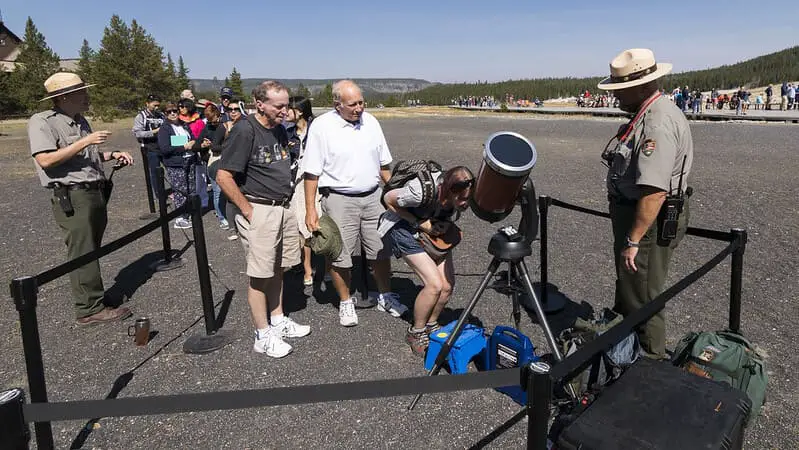
Upcoming Solar Eclipses in the US
If you missed the awe-inspiring total solar eclipse on August 21, 2017, don’t worry—I’ve got great news for you.
There are more opportunities on the celestial horizon to witness this mesmerizing phenomenon in the United States shortly.
So, mark your calendars and keep your eyes on the skies for these upcoming solar eclipses that will be visible from the US or parts of it:
August 21, 2017: A Spectacular Memory
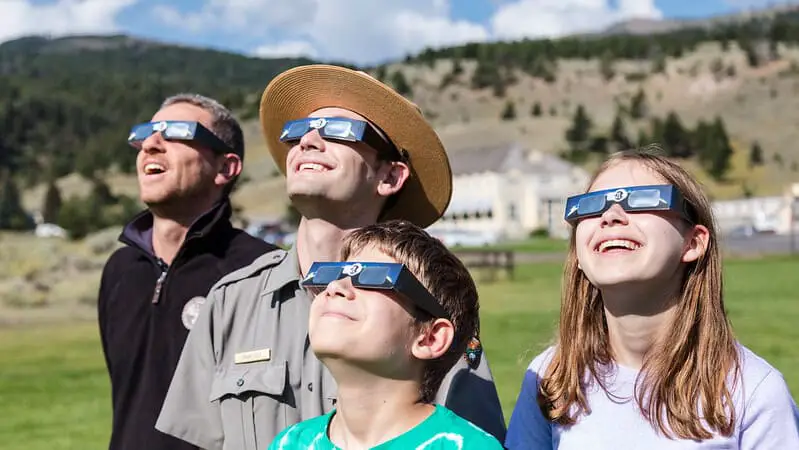
On this unforgettable date, the last total solar eclipse graced the skies of the US. It left spectators in awe as the Moon completely obscured the Sun, casting a breathtaking shadow across the land.
June 10, 2021: A Glimpse of Shadows
While it might not have been total, the partial solar eclipse of June 10, 2021, allowed parts of the northeastern US, including New York, Boston, Philadelphia, and Washington DC, to catch a fascinating glimpse.
April 8, 2024: Total Eclipse Extravaganza
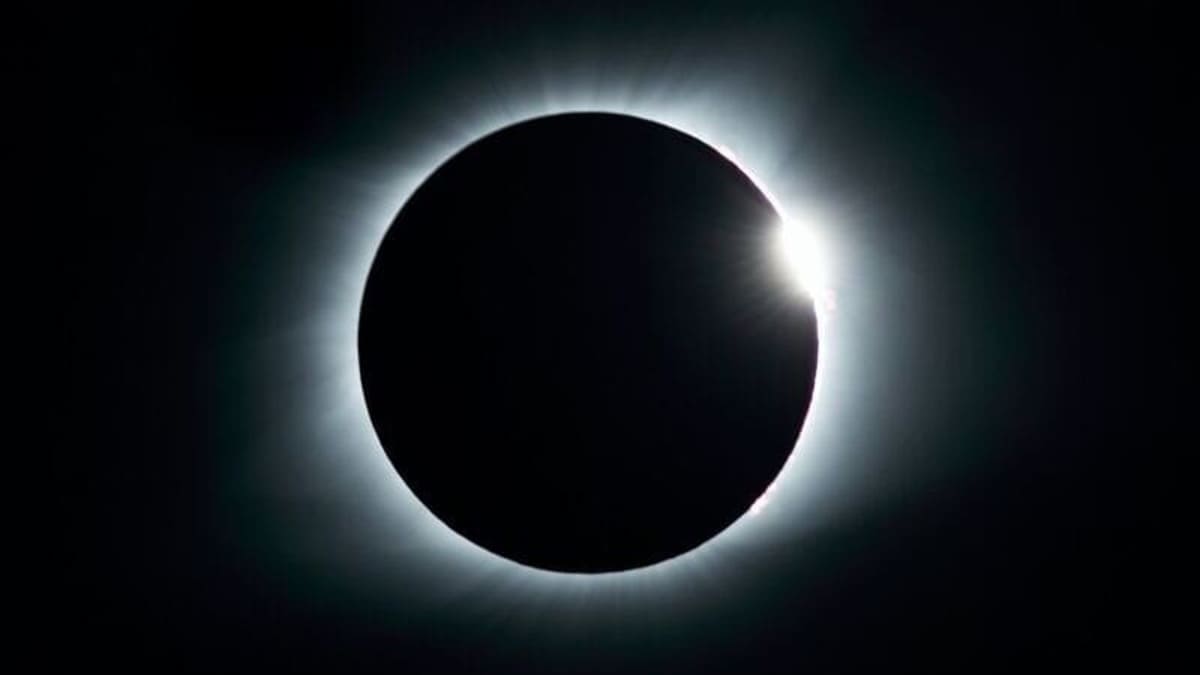
And finally, the grand event that sky enthusiasts eagerly anticipate is the total solar eclipse on April 8, 2024. This celestial spectacle will traverse an impressive 15 states, journeying from Texas to Maine. It will pass through major cities like Dallas, Indianapolis, Cleveland, Buffalo, and even Montreal.
This will be the first total eclipse in the US since 2017, and it promises to be a once-in-a-generation experience.
Don’t miss it; the next total eclipse won’t grace our skies until 2045.
Taking Part in Future Eclipses
If you’re eager to embrace the thrill of a solar eclipse, there’s an extraordinary journey ahead, and planning and preparing diligently is essential
Here’s a comprehensive guide to ensure you make the most of your eclipse adventure:
Safety First: Protect Your Eyes

Staring directly at the Sun can lead to permanent eye damage or blindness.
Always prioritize your eye protection. Equip yourself with special eclipse glasses or filters to block out most of the Sun’s blinding light.
- Read my articles
Alternatively, consider using indirect methods like pinhole cameras or projection devices to safely project an image of the Sun onto a screen or surface.
Choose Your Ideal Location
Selecting the perfect viewing location is crucial, as it can significantly enhance your eclipse experience. Depending on the type of eclipse, you might need to travel to a specific spot where it will be visible in all its glory.
Weather Matters: Check the Forecast
Staying one step ahead of Mother Nature is essential to ensure a clear, unobstructed view of the eclipse. Clouds can dash your hopes of witnessing this celestial phenomenon. Hence, avoiding regions notorious for bad weather or poor visibility is wise.
Eclipse Photography: Capture the Magic
While indulging in this extraordinary celestial show, remember to immortalize the moment. Capture the eclipse’s magic through photography or video recording.
- Read my article: Can I take a photo of a solar eclipse?
Share the beauty with the world as you observe the gradual transformation of the environment and the intriguing reactions of wildlife. Whether you’re a seasoned photographer or a novice with a smartphone, this is your chance to document the wonders of the universe.
Community Connection: Share and Connect
Remember that you’re not alone in this experience. Solar eclipses have a unique ability to bring people together in awe and wonder. Share your thoughts, emotions, and photos with fellow eclipse enthusiasts. Connect with your local astronomy club or engage in online forums to join the conversation and bond over the shared excitement.
The Science Behind Eclipses

Understanding the Celestial Alignment
Have you ever wondered about the captivating cosmic ballet that leads to a solar eclipse? It’s a fascinating interplay of celestial bodies driven by incredible coincidences.
Let’s uncover its secrets:
A Dance of Size and Distance
Despite their vast differences in size, the Sun and the Moon appear almost identical in the sky. The Sun dwarfs the Moon, being approximately 400 times larger but also conveniently about 400 times farther away from Earth. This delicate balance means that when the Moon reaches its closest point to our planet, perigee, it can completely obscure the Sun’s radiant disk, creating a spellbinding total eclipse. Conversely, when the Moon lingers at its farthest point, apogee, it leaves a dazzling ring of sunlight encircling its dark silhouette—an enchanting annular eclipse.
The Lunar Phases: A Celestial Choreography
The intricate alignment of the Sun, Moon, and Earth also hinges on the Moon’s ever-changing phases. A solar eclipse exclusively occurs when the Moon is in its new phase. In this cosmic rendezvous, the Moon positions itself directly between the Earth and the Sun, casting its shadow upon our planet.
However, the story continues. Thanks to a cosmic twist, not every new moon ushers in a solar eclipse. The Moon’s orbit is tilted by approximately 5 degrees in relation to Earth’s orbit around the Sun. Consequently, most of the time, the Moon either hovers above or dips below the plane of Earth’s orbit, remaining elusive in its shadow-casting role.
Eclipse Cycles: Cosmic Recurrence
These celestial ballets aren’t fleeting moments; they follow predictable patterns. Solar eclipses occur in cycles, with families of eclipses sharing similar characteristics. The recurrence of these cosmic events adds an extra layer of intrigue to the celestial show, allowing astronomers to anticipate and plan for these awe-inspiring moments.
Path of Totality: Where Darkness Reigns
Within the theater of a total solar eclipse lies a phenomenon known as the “path of totality.” It’s the precise track on Earth’s surface where fortunate observers can witness the Sun’s complete disappearance behind the Moon. The duration of totality varies from one eclipse to another, but for those within this path, it’s an unforgettable experience of darkness and wonder.
The Role of Lunar Nodes in Eclipses
Ever wondered about the celestial mechanics that give rise to the mesmerizing phenomenon of solar eclipses? It’s a divine dance that involves the mysterious lunar nodes.
The Enigmatic Lunar Nodes
The lunar nodes, often ascending and descending nodes, are the two key points where the Moon’s orbital path intersects with the plane of Earth’s journey around the Sun.
The ascending node signifies where the Moon is heading northward across this plane, while the descending node marks its southward trajectory. These nodes serve as celestial signposts, guiding us to critical moments in the eclipse calendar.
Eclipse Seasons: Cosmic Windows
Eclipse seasons are pivotal chapters in the cosmic narrative, each lasting approximately 34 days. They come into play because of the lunar nodes. These seasons are the prime time for solar eclipses, occurring twice a year. It’s during these windows that the celestial choreography aligns just right.
Eclipse Types: A Spectrum of Splendor
During an eclipse season, the type of solar eclipse that graces our skies depends on the proximity of the new Moon to the lunar node. When the new Moon cozies up close to the node, it sets the stage for a captivating total or annular eclipse, where the Sun is either entirely or partially obscured.
However, when the new Moon ventures farther from the node, it treats us to a partial eclipse, a spectacle where only a portion of the Sun’s brilliance is veiled.
Eclipse Frequency: A Cosmic Rhythm
Thanks to the lunar nodes, solar eclipses follow a rhythmic pattern. They occur about twice a year during eclipse seasons, allowing us to witness the cosmic ballet unfold.
These celestial events remind us of the intricate interconnectedness of our universe and the stunning beauty that emerges from such alignment.
Summary: Solar Eclipse in the US
Thank you for reading my article “How often is a Solar Eclipse in the US.”
A solar eclipse is a fascinating and awe-inspiring event that reveals the beauty and complexity of our solar system.
It also offers a unique opportunity to learn more about the Sun, the Moon, and the Earth, and how they interact with each other.
By understanding how often a solar eclipse occurs in the US, how it has been perceived throughout history, and what to expect from future eclipses, you can prepare to witness and enjoy this unique phenomenon.
Interested in more Solar Eclipse articles?
- Does it Go Dark During an Eclipse?
- Seeing Stars During a Solar Eclipse?
- How Long Do Solar Eclipses Last?
- Can I take a photo of a solar eclipse?
- Can you look at a solar eclipse without sunglasses?
- How Do Solar Eclipse Glasses Work?
- DIY Solar Filter Telescope: 5-Step Easy Guide
- What is a Hybrid Solar Eclipse?




